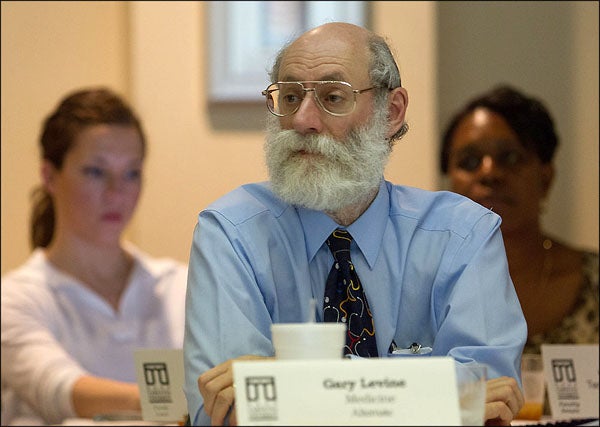IN PHASE TWO
Committee unveils potential cost savings for academic reorganization
East Carolina University could save up to $3.8 million annually by reorganizing its academic structure.
That estimate was released March 30 in a report from the chancellor-appointed Program Prioritization Committee. It outlines four possible scenarios for reorganization, which range in scope from implementing no change to dismantling up to three existing colleges: the College of Human Ecology, the College of Health and Human Performance and the Thomas Harriot College of Arts and Sciences. The programs currently grouped within those colleges would be assigned to other units.
Cuts to administrative spending would produce the most savings, according to the report. Several changes would lead to the elimination of deans, chairs or directors, and a reduction of fixed-term faculty is also proposed. Committee members have expressed their awareness at forums of the potential human toll of reorganization.
The scenarios released today represent the second phase of the committee’s work since its creation in May 2011, which aims to reduce expenditures while improving academic quality. ECU took a 16.1 percent budget cut in state funding for the 2011-2012 fiscal year following four consecutive years of state budget cuts.
Phase I included the identification of individual programs across the university for investment, maintenance, reduction or elimination. Committee chair Ron Mitchelson said cost savings will be associated with those decisions, too.
“If you’re saving $2 million of $210 million (the combined total state budget for Academic Affairs and Health Sciences), that’s about 1 percent,” said Mitchelson, a geography professor at ECU. “I think it’s at the level we were expecting. It’s a reasonable approach.”
Potential changes to the College of Arts and Sciences would result in the creation of a social and behavioral sciences and humanities college, as well as a STEM college focused on science, technology, engineering and mathematics, the report states. Mitchelson said there are many people on campus intrigued by the potential benefits of a STEM college.
The committee also suggests that $1 million could be saved annually by analyzing academic administrative costs across campus, even if structural changes aren’t made. Under that plan, an estimated $650,000 would be cut from the Academic Affairs budget – the largest of ECU’s three academic divisions – with Health Sciences forfeiting $350,000 annually.
“We’re creating a bit of pressure for the units to self-evaluate,” Mitchelson said.
A series of forums will be held beginning April 9 so that faculty and staff can provide feedback on each of the scenarios. Following that input period, the committee will recommend one scenario to the chancellor by April 30.
“We’re here to listen,” Mitchelson said. “It’s going to be a difficult decision. There are tradeoffs (with each scenario). And we’ve said from the beginning that if the money isn’t worth the disruption, maybe we shouldn’t do it.”
For more information on the committee or to view the documents they produced, visit www.ecu.edu/ppc.
Scenario 1
Estimated savings $1 million per year
- Enact no structural changes.
- All colleges must submit a strategic plan for increased administrative efficiency with savings targeted at 0.5 percent of the total permanent state budget for Academic Affairs and Health Sciences divisions (approx. $1 million per year).
Scenario 2
Estimated savings $1.6 million per year
- Implement Scenario 1.
- Move Nutrition Sciences to the College of Health and Human Performance or to the Health Sciences division.
- Move Interior Design to the College of Fine Arts and Communication’s School of Art & Design.
- Move Merchandising to the College of Business’ Department of Marketing and Supply Chain Management.
- Move Hospitality Management to College of Business.
- Move Physician Assistant Studies to Brody School of Medicine, into Family Medicine.
- Move Clinical Lab Science to Brody School of Medicine, into Pathology & Lab Medicine.
- Merge Business & Information Technology Education (BITE) and Library Science within College of Education.
- Move centers and institutes to college-level hosts with the possibility of creating a School of the Coast and Sustainable Environment. (Institute for Coastal Science and Policy and Renaissance Computing Institute to the Harriot College of Arts & Sciences; Center for Sustainable Tourism to the College of Business; N.C. Agromedicine Institute and Center for Health Disparities Research to the Brody School of Medicine.)
- Move ECU-TV from Laupus Health Sciences Library to Communications, Marketing and Public Affairs.
- Adjust operations at Laupus and Joyner libraries to reduce duplication and improve efficiencies.
Scenario 3A
Estimated savings $2.6 million per year
- Enact Scenario 1
- Enact Scenario 2
- Distribute College of Human Ecology.
- Move Child Development and Family Relations to College of Education or College of Allied Health Sciences.
- Move Criminal Justice to Harriot College of Arts & Sciences.
- Move Social Work to College of Allied Health Sciences.
Scenario 3B
Estimated savings $2.5 million per year
- Enact Scenario 1
- Enact Scenario 2
- Distribute College of Health and Human Performance.
- Merge Recreation and Leisure Studies and Hospitality Management within the College of Business.
- Move Environmental Health & Promotion to the Brody School of Medicine’s Department of Public Health.
- Move School Health Education and Physical Education to College of Education’s Department of Curriculum and Instruction.
- Move Kinesiology to College of Allied Health Sciences.
- Move Nutrition Sciences from College of Human Ecology to College of Allied Health Sciences.
Scenario 3C
Estimated savings $2 million per year
- Enact Scenario 1.
- Enact Scenario 2.
- Create new College of Science, Technology, Engineering and Mathematics (STEM): Construction Management, Technology Systems, Engineering, Computer Science, Biology, Chemistry, Geological Sciences, Mathematics, Physics.
- Create new College of Social & Behavioral Sciences and the Humanities: Anthropology, Foreign Languages & Literatures, Geography, History, Philosophy, Political Science, Sociology, Economics, English, Psychology.
Scenario 4
Estimated savings range from $2.9 to $3.8 million per year
- Enact Scenario 1
- Enact Scenario 2
- Combine two or more options within Scenario 3
